Weakly Supervised Ternary Stream Data Augmentation Fine-Grained Classification Network for Identifying Acute Lymphoblastic Leukemia
Abstract
:1. Introduction
2. Materials and Methods
2.1. Embedding Weakly Supervised Attention Learning
2.2. Attention Cropping Stream
2.3. Attention Erasing Stream
2.4. Voting Strategy
| Algorithm 1. Coarse-to-Fine Prediction. |
| Require: Trained WT-DFN model |
| for do (batch size ) 1: Obtain raw probability and out attention maps by Equation (1); 2: Calculate normalize by Equation (2); 3: Obtain crop image and erase image by Equations (3) and (4), respectively; 4: Predict fine-grained probability , ; 5: Calculate the final prediction by Equation (5); end for return |
2.5. Dataset and Evaluation Metrics
3. Results
3.1. Experimental Setting
3.2. Comparisons with State-of-the-Art Data Augmentation Works
3.3. WT-DFN Performance on ResNets
3.4. Comparison of the Proposed Classification Model with Other Methods
| Methods | Final WF1S(%) Trained on Phase-I and II Tested on Phase-III |
|---|---|
| MobileNetV2 + [33] | 89.47 |
| SE-ResNeXt + [34] | 88.91 |
| SENet + [35] | 87.9 |
| InceptionV2 + [36] | 87.6 |
| Inception ResNetV2 + [37] | 84.8 |
| NCA + [38] | 91.04 |
| DeepMEN + [39] | 88.56 |
| LSTM-DENSE + [40] | 86.6 |
| Stacking + [41] | 85.52 |
| WT-DFN | 92.30 |
3.5. Convergence Analysis
3.6. Experimentation on the Clinical Dataset
3.7. Ablation Studies
4. Discussion
5. Conclusions
Author Contributions
Funding
Institutional Review Board Statement
Informed Consent Statement
Data Availability Statement
Conflicts of Interest
References
- Brown, P.A.; Shah, B.; Fathi, A.; Wieduwilt, M.; Advani, A.; Aoun, P.; Barta, S.K.; Boyer, M.W.; Bryan, T.; Burke, P.W.; et al. NCCN Guidelines Insights: Acute Lymphoblastic Leukemia, Version 1.2017. J. Natl. Compr. Cancer Netw. JNCCN 2017, 15, 1091–1102. [Google Scholar] [CrossRef] [Green Version]
- Pui, C.H.; Robison, L.L.; Look, A.T. Acute lymphoblastic leukaemia. Lancet 2008, 371, 1030–1043. [Google Scholar] [CrossRef]
- Brown, P.A.; Wieduwilt, M.; Logan, A.; DeAngelo, D.J.; Wang, E.S.; Fathi, A.; Cassaday, R.D.; Litzow, M.; Advani, A.; Aoun, P.; et al. Guidelines Insights: Acute Lymphoblastic Leukemia, Version 1.2019. J. Natl. Compr. Cancer Netw. JNCCN 2019, 17, 414–423. [Google Scholar] [CrossRef]
- Cheung, Y.T.; Brinkman, T.M.; Mulrooney, D.A.; Mzayek, Y.; Liu, W.; Banerjee, P.; Panoskaltsis-Mortari, A.; Srivastava, D.; Pui, C.H.; Robison, L.L.; et al. Impact of sleep, fatigue, and systemic inflammation on neurocognitive and behavioral outcomes in long-term survivors of childhood acute lymphoblastic leukemia. Cancer 2017, 123, 3410–3419. [Google Scholar] [CrossRef] [PubMed]
- Bennett, J.M.; Catovsky, D.; Daniel, M.-T.; Flandrin, G.; Galton, D.A.G.; Gralnick, H.R.; Sultan, C. Proposals for the classification of the acute leukaemias. French-American-British (FAB) co-operative group. Br. J. Haematol. 1976, 33, 451–458. [Google Scholar] [CrossRef] [PubMed]
- Palmer, L.; Briggs, C.; McFadden, S.; Zini, G.; Burthem, J.; Rozenberg, G.; Proytcheva, M.; Machin, S.J. ICSH recommendations for the standardization of nomenclature and grading of peripheral blood cell morphological features. Int. J. Lab. Hematol. 2015, 37, 287–303. [Google Scholar] [CrossRef]
- Abbasi, M.; Kermani, S.; Tajebib, A.; Amin, M.M.; Abbasi, M. Automatic detection of acute lymphoblastic leukaemia based on extending the multifractal features. IET Image Process. 2020, 14, 132–137. Available online: https://digital-library.theiet.org/content/journals/10.1049/iet-ipr.2018.5910 (accessed on 17 September 2021). [CrossRef]
- Sahlol, A.T.; Abdeldaim, A.M.; Hassanien, A.E. Automatic acute lymphoblastic leukemia classification model using social spider optimization algorithm. Soft Comput. 2019, 23, 6345–6360. [Google Scholar] [CrossRef]
- Vogado, L.H.S.; Veras, R.M.S.; Araujo, F.H.D.; Silva, R.R.V.; Aires, K.R.T. Leukemia diagnosis in blood slides using transfer learning in CNNs and SVM for classification. Eng. Appl. Artif. Intell. 2018, 72, 415–422. [Google Scholar] [CrossRef]
- TUBA, M.; Informatics, E. Generative Adversarial Optimization (GOA) for Acute Lymphocytic Leukemia Detection. Stud. Inform. Control 2019, 28, 245–254. [Google Scholar] [CrossRef]
- Hegde, R.B.; Prasad, K.; Hebbar, H.; Singh, B.M.K. Comparison of traditional image processing and deep learning approaches for classification of white blood cells in peripheral blood smear images. Biocybern. Biomed. Eng. 2019, 39, 382–392. [Google Scholar] [CrossRef]
- Gupta, R.; Mallick, P.; Duggal, R.; Gupta, A.; Sharma, O. Stain Color Normalization and Segmentation of Plasma Cells in Microscopic Images as a Prelude to Development of Computer Assisted Automated Disease Diagnostic Tool in Multiple Myeloma. Clin. Lymphoma Myeloma Leuk. 2017, 17, e99. [Google Scholar] [CrossRef]
- Policar, P.G.; Strazar, M.; Zupan, B.J.B. openTSNE: A modular Python library for t-SNE dimensionality reduction and embedding. BioRxiv 2019, 731877. [Google Scholar] [CrossRef] [Green Version]
- Van der Maaten, L.; Hinton, G.J. Visualizing data using t-SNE. J. Mach. Learn. Res. 2008, 9, 2579–2605. [Google Scholar]
- Xie, S.; Girshick, R.; Dollár, P.; Tu, Z.; He, K. Aggregated residual transformations for deep neural networks. In Proceedings of the IEEE Conference on Computer Vision and Pattern Recognition (CVPR), Minneapolis, MI, USA, 18–23 June 2007; pp. 1492–1500. [Google Scholar]
- Hu, J.; Shen, L.; Sun, G. Squeeze-and-excitation networks. In Proceedings of the IEEE Conference on Computer Vision and Pattern Recognition (CVPR), Salt Lake City, UT, USA, 18–23 June 2018; pp. 7132–7141. [Google Scholar]
- Lin, T.; RoyChowdhury, A.; Maji, S. Bilinear CNN Models for Fine-Grained Visual Recognition. In Proceedings of the 2015 IEEE International Conference on Computer Vision (ICCV), Santiago, Chile, 7–13 December 2015; pp. 1449–1457. [Google Scholar]
- Duggal, R.; Gupta, A.; Gupta, R.; Wadhwa, M.; Ahuja, C. Overlapping cell nuclei segmentation in microscopic images using deep belief networks. In Proceedings of the Tenth Indian Conference on Computer Vision, Graphics and Image Processing, Guwahati, Assam, India, 18–22 December 2016; p. 82. [Google Scholar]
- Duggal, R.; Gupta, A.; Gupta, R.; Mallick, P. SD-Layer: Stain Deconvolutional Layer for CNNs in Medical Microscopic Imaging; Springer International Publishing: Cham, Switzerland, 2017. [Google Scholar]
- Paszke, A.; Gross, S.; Chintala, S.; Chanan, G.; Yang, E.; DeVito, Z.; Lin, Z.; Desmaison, A.; Antiga, L.; Lerer, A. Automatic differentiation in pytorch. In Proceedings of the 2017 Conference on Neural Information Processing Systems, Long Beach, CA, USA, 4–9 December 2017. [Google Scholar]
- Yong, H.; Huang, J.; Hua, X.; Zhang, L. Gradient Centralization: A New Optimization Technique for Deep Neural Networks. arXiv 2020, arXiv:2004.01461. Available online: https://ui.adsabs.harvard.edu/abs/2020arXiv200401461Y (accessed on 17 September 2021).
- Prechelt, L. Early Stopping—But When? In Neural Networks: Tricks of the Trade; Orr, G.B., Müller, K.-R., Eds.; Springer: Berlin/Heidelberg, Germany, 1998; pp. 55–69. [Google Scholar]
- He, K.; Zhang, X.; Ren, S.; Sun, J. Deep residual learning for image recognition. In Proceedings of the IEEE Conference on Computer Vision and Pattern Recognition, Las Vegas, NV, USA, 27–30 June 2016; pp. 770–778. [Google Scholar]
- Hendrycks, D.; Mu, N.; Cubuk, E.D.; Zoph, B.; Gilmer, J.; Lakshminarayanan, B. AugMix: A Simple Data Processing Method to Improve Robustness and Uncertainty. arXiv 2019, arXiv:1912.02781. [Google Scholar]
- Zhong, Z.; Zheng, L.; Kang, G.; Li, S.; Yang, Y. Random erasing data augmentation. Proc. AAAI Conf. Artif. Intell. 2020, 34, 13001–13008. [Google Scholar] [CrossRef]
- Zhang, H.; Cisse, M.; Dauphin, Y.N.; Lopez-Paz, D. Mixup: Beyond Empirical Risk Minimization. arXiv 2017, arXiv:1710.09412. [Google Scholar]
- Yun, S.; Han, D.; Oh, S.J.; Chun, S.; Choe, J.; Yoo, Y. CutMix: Regularization strategy to train strong classifiers with localizable features. In Proceedings of the IEEE/CVF International Conference on Computer Vision; Institute of Electrical and Electronics Engineers (IEEE): Piscataway, NJ, USA, 2019; pp. 6023–6032. [Google Scholar]
- Cubuk, E.D.; Zoph, B.; Mane, D.; Vasudevan, V.; Le, Q.V. AutoAugment: Learning Augmentation Policies from Data. arXiv 2018, arXiv:1805.09501. [Google Scholar]
- Cubuk, E.D.; Zoph, B.; Shlens, J.; Le, Q.V. RandAugment: Practical automated data augmentation with a reduced search space. In Proceedings of the IEEE/CVF Conference on Computer Vision and Pattern Recognition Workshops; Institute of Electrical and Electronics Engineers (IEEE): Piscataway, NJ, USA, 2020; pp. 702–703. [Google Scholar]
- DeVries, T.; Taylor, G.W.J. Improved regularization of convolutional neural networks with cutout. arXiv 2017, arXiv:1708.04552. [Google Scholar]
- Chen, P.; Liu, S.; Zhao, H.; Jia, J.J. Gridmask data augmentation. arXiv 2020, arXiv:2001.04086. [Google Scholar]
- Touvron, H.; Vedaldi, A.; Douze, M.; Jégou, H.J. Fixing the train-test resolution discrepancy. arXiv 2019, arXiv:1906.06423. Available online: https://ui.adsabs.harvard.edu/abs/2019arXiv190606423T (accessed on 17 September 2021).
- Verma, E.; Singh, V. ISBI Challenge 2019: Convolution Neural Networks for B-ALL Cell Classification; Springer: Singapore, 2019; pp. 73–82. [Google Scholar]
- Prellberg, J.; Kramer, O.J.A. Acute lymphoblastic leukemia classification from microscopic images using convolutional neural networks. In ISBI 2019 C-NMC Challenge: Classification in Cancer Cell Imaging; Springer: Singapore, 2019. [Google Scholar]
- Shi, T.; Wu, L.; Zhong, C.; Wang, R.; Zheng, W. Ensemble Convolutional Neural Networks for Cell Classification in Microscopic Images; Springer: Singapore, 2019; pp. 43–51. [Google Scholar]
- Liu, Y.; Long, F. Acute lymphoblastic leukemia cells image analysis with deep bagging ensemble learning. BioRxiv 2019, 580852. [Google Scholar] [CrossRef]
- Xie, X.; Li, Y.; Zhang, M.; Wu, Y.; Shen, L. Multi-Streams and Multi-Features for Cell Classification; Springer: Singapore, 2019; pp. 95–102. [Google Scholar]
- Pan, Y.; Liu, M.; Xia, Y.; Shen, D. Neighborhood-Correction Algorithm for Classification of Normal and Malignant Cells; Springer: Singapore, 2019; pp. 73–82. [Google Scholar]
- Xiao, F.; Kuang, R.; Ou, Z.; Xiong, B. DeepMEN: Multi-Model Ensemble Network for B-Lymphoblast Cell Classification; Springer: Singapore, 2019; pp. 83–93. [Google Scholar]
- Shah, S.; Nawaz, W.; Jalil, B.; Khan, H.A. Classification of Normal and Leukemic Blast Cells in B-ALL Cancer Using a Combination of Convolutional and Recurrent Neural Networks; Springer: Singapore, 2019; pp. 23–31. [Google Scholar]
- Ding, Y.; Yang, Y.; Cui, Y. Deep Learning for Classifying of White Blood Cancer; Springer: Singapore, 2019; pp. 33–41. [Google Scholar]
- Sandler, M.; Howard, A.; Zhu, M.; Zhmoginov, A.; Chen, L.-C. Mobilenetv2: Inverted residuals and linear bottlenecks. In Proceedings of the IEEE Conference on Computer Vision and Pattern Recognition, Salt Lake City, UT, USA, 18–23 June 2018; pp. 4510–4520. [Google Scholar]
- Szegedy, C.; Ioffe, S.; Vanhoucke, V.; Alemi, A.A. Inception-v4, inception-resnet and the impact of residual connections on learning. In Proceedings of the Thirty-First AAAI Conference on Artificial Intelligence, San Francisco, CA, USA, 4–9 February 2017. [Google Scholar]
- Rios, A.; Kavuluru, R. Convolutional neural networks for biomedical text classification: Application in indexing biomedical articles. In Proceedings of the 6th ACM Conference on Bioinformatics, Computational Biology and Health Informatics, New York, NY, USA, 9–12 September 2015. [Google Scholar]
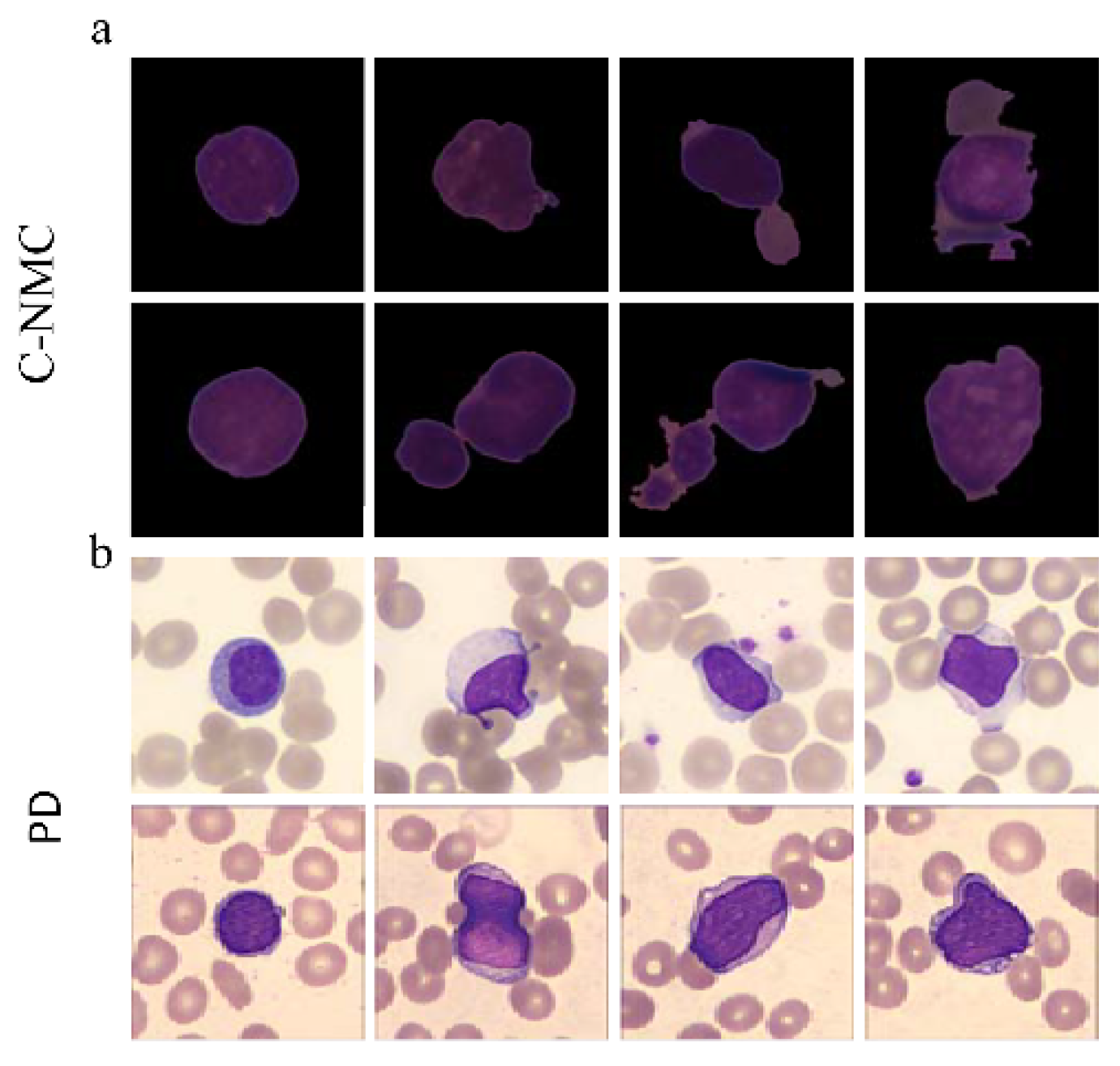
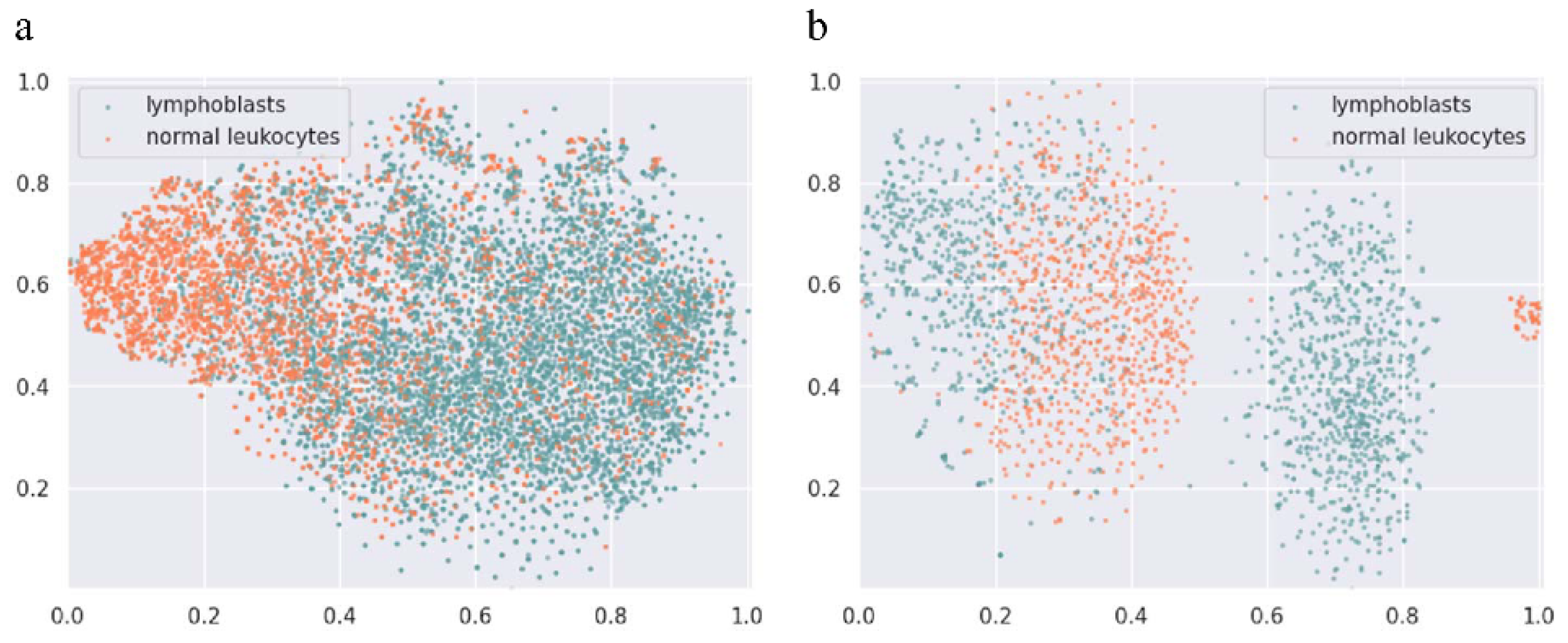


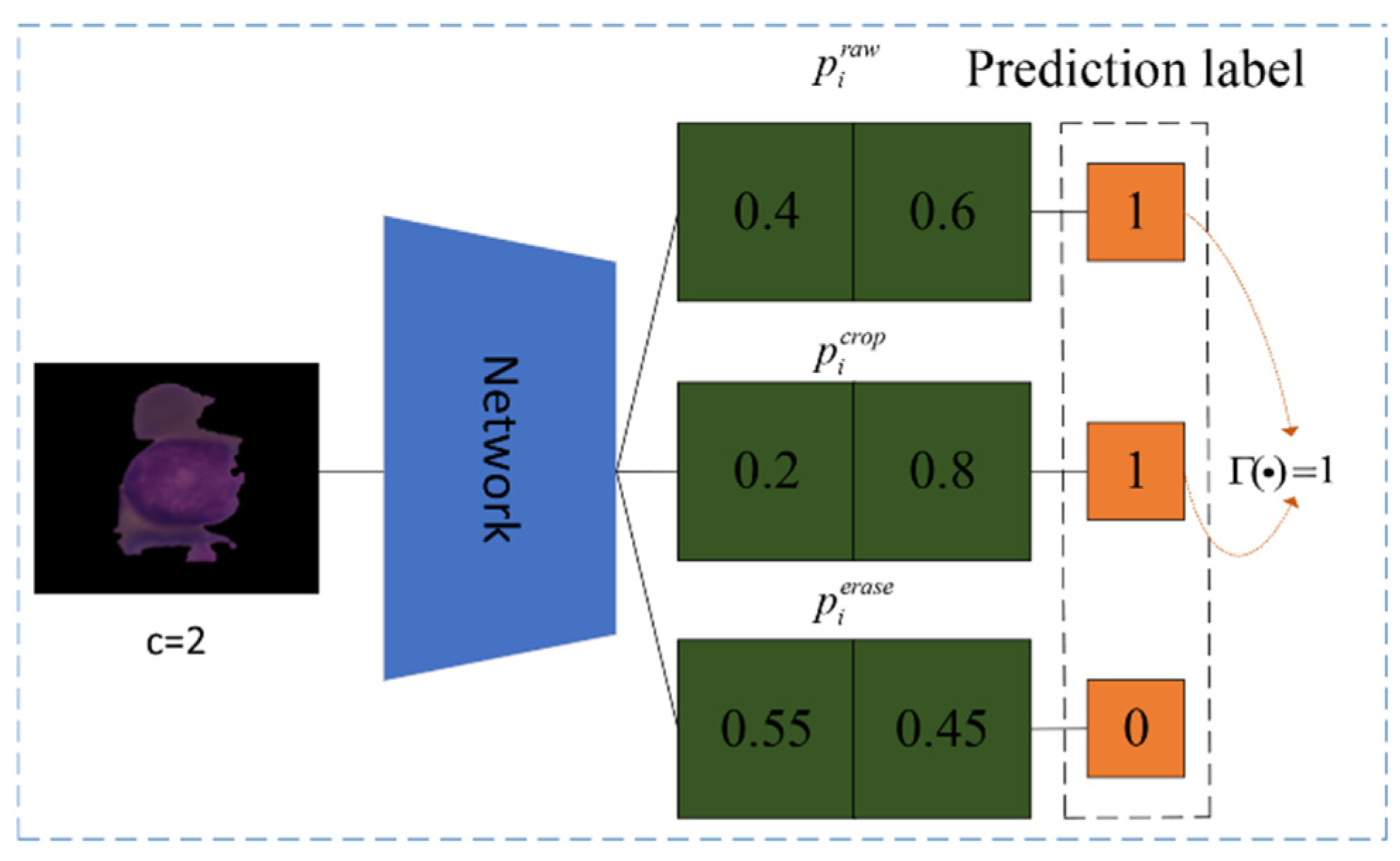
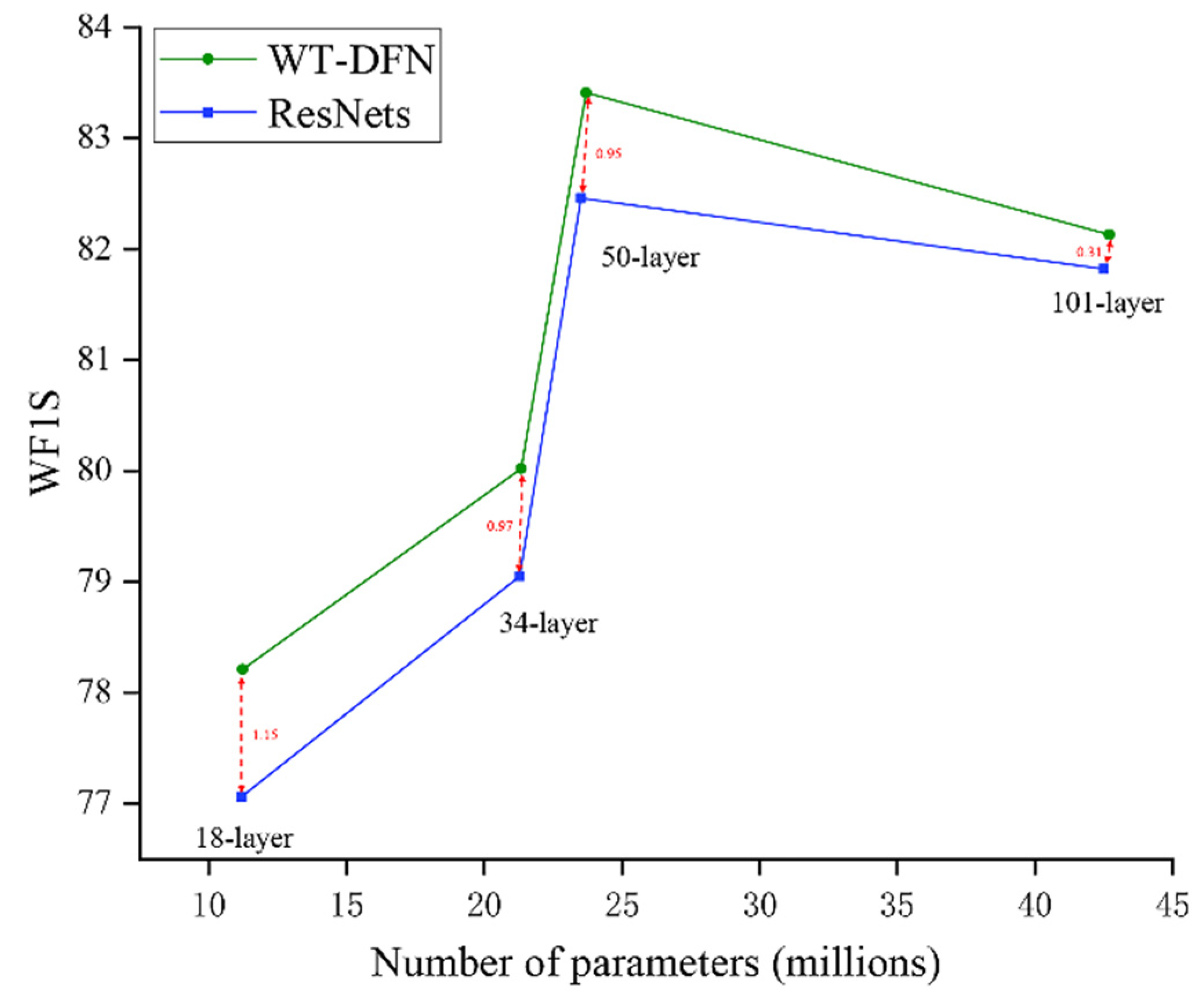
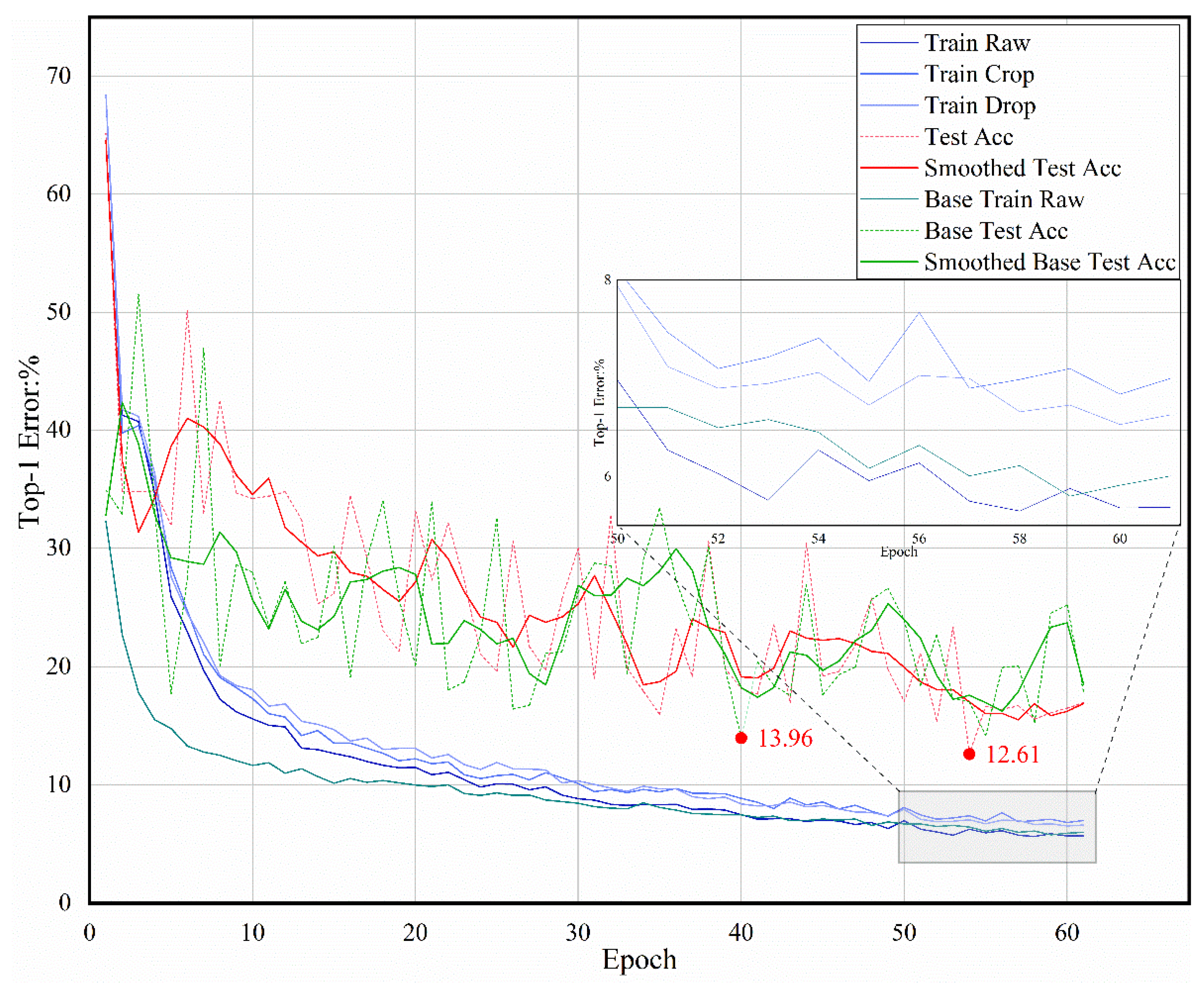
| Method | WF1S |
|---|---|
| RE | |
| RA | |
| MU | |
| CM | |
| AM | |
| CO | |
| GM | |
| WT-DFN |
| Backbone | Without WT-DFN | With WT-DFN | ||||||||
|---|---|---|---|---|---|---|---|---|---|---|
| Parameters | FLOPS | Top-1 acc | AUC | WF1S | Parameters | FLOPS | Top-1 acc | AUC | WF1S | |
| ResNet18 | 11.18M | 3.61G | 59.38 | 51.78 | 57.97 | 11.23M | 3.62G | 78.88 | 81.01 | 80.50 |
| ResNet34 | 21.29M | 7.32G | 62.17 | 62.08 | 62.53 | 21.34M | 7.33G | 78.80 | 79.65 | 79.32 |
| SE-ResNeXt26 | 14.75M | 4.95G | 78.02 | 82.73 | 78.64 | 14.94M | 4.96G | 85.33 | 87.00 | 85.65 |
| SE-ResNeXt50 | 25.51M | 8.51G | 77.01 | 82.75 | 77.56 | 25.71M | 8.52G | 88.44 | 86.02 | 88.36 |
| MobileNetV2 | 2.23M | 0.63G | 66.96 | 50.00 | 53.72 | 2.35M | 0.64G | 85.97 | 82.61 | 85.52 |
| InceptionV1 | 5.98M | 3.16G | 78.57 | 79.04 | 78.99 | 7.10M | 3.16G | 91.43 | 91.30 | 91.50 |
| InceptionV2 | 13.47M | 3.79G | 67.41 | 72.76 | 67.10 | 13.57M | 3.79G | 88.76 | 85.60 | 88.44 |
| InceptionV3 | 21.79M | 5.91G | 78.57 | 81.77 | 79.14 | 21.99M | 5.91G | 79.87 | 79.87 | 80.32 |
| InceptionV4 | 41.15M | 12.61G | 90.49 | 90.52 | 90.72 | 41.29M | 12.61G | 91.97 | 90.05 | 91.90 |
| Inception ResNetV2 | 54.31M | 13.49G | 82.26 | 78.53 | 81.14 | 54.46M | 13.49G | 88.12 | 88.66 | 88.36 |
| Preliminary WF1S(%) | Total Time ∆ (m) | |
|---|---|---|
| 4 | 83.79 | 17.78 |
| 16 | 86.24 | 17.80 |
| 32 | 87.12 | 17.89 |
| 64 | 85.98 | 18.40 |
Publisher’s Note: MDPI stays neutral with regard to jurisdictional claims in published maps and institutional affiliations. |
© 2021 by the authors. Licensee MDPI, Basel, Switzerland. This article is an open access article distributed under the terms and conditions of the Creative Commons Attribution (CC BY) license (https://creativecommons.org/licenses/by/4.0/).
Share and Cite
Liu, Y.; Chen, P.; Zhang, J.; Liu, N.; Liu, Y. Weakly Supervised Ternary Stream Data Augmentation Fine-Grained Classification Network for Identifying Acute Lymphoblastic Leukemia. Diagnostics 2022, 12, 16. https://doi.org/10.3390/diagnostics12010016
Liu Y, Chen P, Zhang J, Liu N, Liu Y. Weakly Supervised Ternary Stream Data Augmentation Fine-Grained Classification Network for Identifying Acute Lymphoblastic Leukemia. Diagnostics. 2022; 12(1):16. https://doi.org/10.3390/diagnostics12010016
Chicago/Turabian StyleLiu, Yunfei, Pu Chen, Junran Zhang, Nian Liu, and Yan Liu. 2022. "Weakly Supervised Ternary Stream Data Augmentation Fine-Grained Classification Network for Identifying Acute Lymphoblastic Leukemia" Diagnostics 12, no. 1: 16. https://doi.org/10.3390/diagnostics12010016
APA StyleLiu, Y., Chen, P., Zhang, J., Liu, N., & Liu, Y. (2022). Weakly Supervised Ternary Stream Data Augmentation Fine-Grained Classification Network for Identifying Acute Lymphoblastic Leukemia. Diagnostics, 12(1), 16. https://doi.org/10.3390/diagnostics12010016







